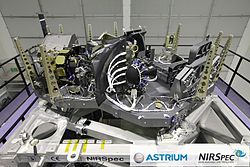NIRSpec (Near-Infrared Spectrograph)

NIRSpec Instrument within the Astrium Cleanroom in Ottobrunn, Germany
|
|
| Mission type | Astronomy |
|---|---|
| Operator | ESA with contributions from NASA |
| Website |
ESA Europe Astrium Germany NASA United States |
| Mission duration | 5 years (design) 10 years (goal) |
| Spacecraft properties | |
| Manufacturer | Astrium |
| Launch mass | 196 kg (432 lb) |
| Start of mission | |
| Launch date | October 2018 (planned) |
| Rocket | As part of JWST onboard Ariane 5 |
| Launch site | Kourou ELA-3 |
| Contractor | Arianespace |
| Main telescope | |
| Type | Spectrograph |
| Wavelengths | 0.6 µm (orange) to 5.0 µm (near-infrared) |
The NIRSpec (Near-Infrared Spectrograph) is one of the four scientific instruments which will be flown on the James Webb Space Telescope (JWST). The JWST is the follow-on mission to the Hubble Space Telescope (HST) and is developed to receive more information about the origins of the universe by observing infrared light from the first stars and galaxies. In comparison to HST, its instruments will allow looking further back in time and will study the so-called Dark Ages during which the universe was opaque, about 150 to 800 million years after the Big Bang.
The NIRSpec instrument is a multi-object spectrograph and is capable of simultaneously measuring the near-infrared spectrum of up to 100 objects like stars or galaxies with low, medium and high spectral resolutions. The observations are performed in a 3 arcmin × 3 arcmin field of view over the wavelength range from 0.6 µm to 5.0 µm. It also features a set of slits and an aperture for high contrast spectroscopy of individual sources, as well as an integral-field unit (IFU) for 3D spectroscopy. The instrument is a contribution of the European Space Agency (ESA) and is built by Astrium together with a group of European subcontractors.
The JWST main science themes are:
The NIRSpec instrument operates at -235 °C and is passively cooled by cold space radiators which are mounted on the JWST Integrated Science Instrument Module (ISIM). The radiators are connected to NIRSpec using thermally conductive heat straps. The mirror mounts and the optical bench base plate all manufactured out of silicon carbide ceramic SiC100. The instrument size is approximately 1900 mm × 1400 mm × 700 mm and weighs 196 kg (432 lb) including 100 kg of silicon carbide. The operation of the instrument is performed with three electronic boxes.
NIRSpec includes 4 mechanisms which are:
...
Wikipedia
